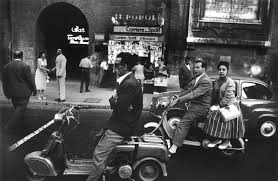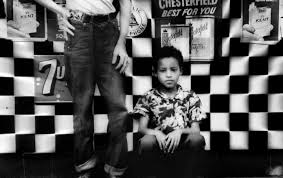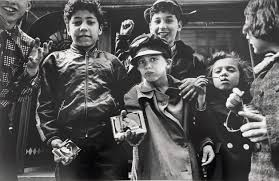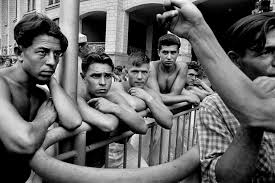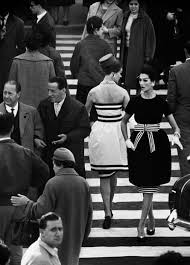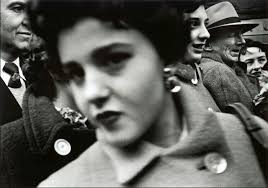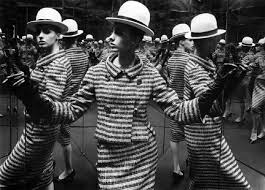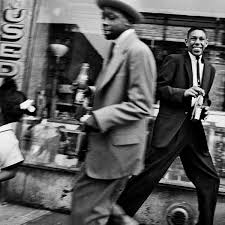Henri Cartier-Bresson’s Approach
He preferred composition, timing and intuition rather than free reign, staged or manipulated shots. Cartier-Bresson believed in spontaneity and he often compared photography to a form of visual storytelling, where the photographer will act as an observer, waiting for the right moment to unfold. He was influenced by surrealism, which shaped his ability to find extraordinary beauty in everyday life. His used the Leica camera which allowed him to move discreetly, capturing candid moments without disrupting the scene.
He was Formal with this photography because he used the rule of thirds, leading lines. He used Figure-to-Ground Composition which means there was contrast between subjects and the background to make the image clear. Another thing he used was repetition & patterns by doing this it helped strengthen his compositions. His use of shadows made sure depth was added to the photos and it would have gave people a visual interest. A third thing he used was natural light which made sure authenticity was maintained. Finally, He used lots of black and white photography this enhanced and increased the contrast, texture and the composition of his images.
He was a perfectionist. This means he wanted everything perfect in the image. This included composition, shutter speed and the wide angle of his lens. He had a philosophy which revolved around capturing the “decisive moment,” where all elements in a scene aligned perfectly in an instant.
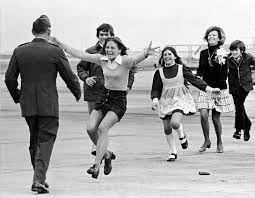
William Klein’s Approach
William Klein’s approach to photography was very bold, unconventional, and chaotic. He was different to Henri Cartier-Bresson, who wanted perfect composition, Klein embraced imperfection, blur, grain, and distortion to create dynamic, energetic images. His style was influenced by his background in painting and his desire to break traditional photographic rules.
Key Aspects of Klein’s Approach:
Close-up, Wide-Angle Shots – He often used wide-angle lenses to exaggerate perspective and create distorted compositions. He was constantly in your face to get the perfect shot and he wasn’t bothered by personal space.
High Contrast & Grain – Klein embraced the rough textures and high contrast to enhance the raw, gritty feel of his images.
Blur & Motion – Instead of avoiding blur, he used it to convey movement, spontaneity and distortion.
Street Photography with Direct Engagement – Unlike Cartier-Bresson’s discreet approach, Klein interacted with his subjects, sometimes provoking reactions to capture raw emotion.
Experimental Fashion Photography – His work for Vogue transformed fashion photography by introducing dynamic, unconventional compositions.
Klein’s work was rebellious and expressive, challenging the norms of photography and influencing generations of photographers.
Comparison of Images
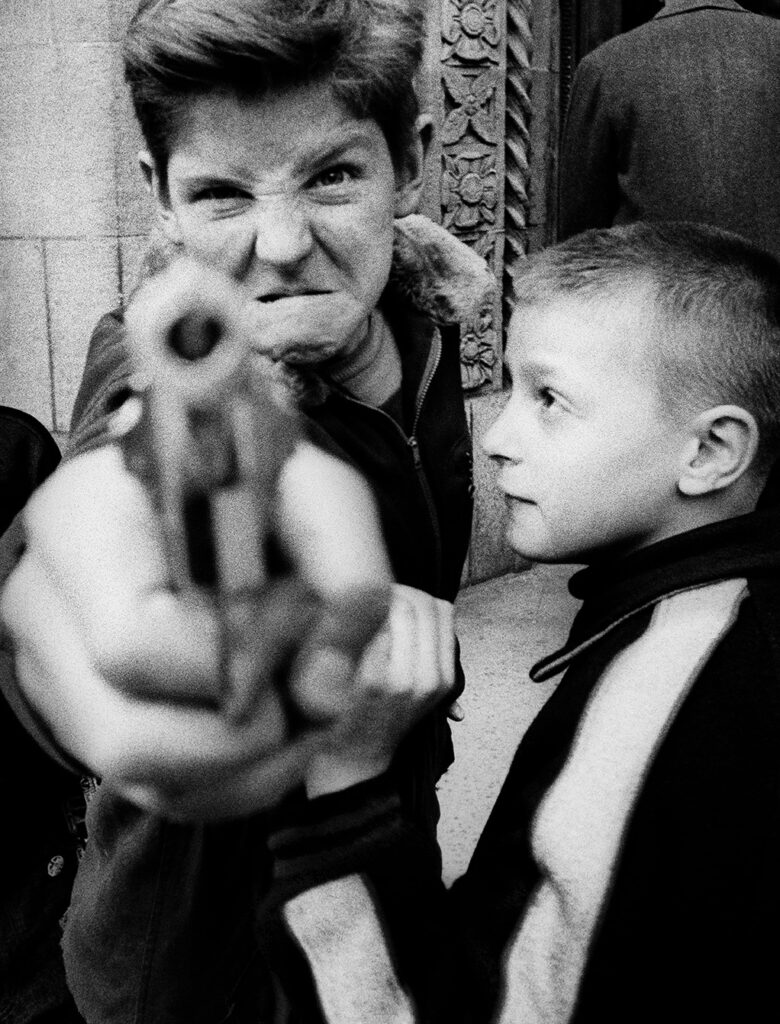
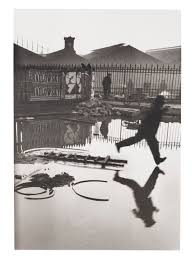
Image Analysis of Henri Cartier-Bresson
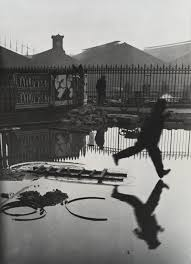
Technical
Used the Leica rangefinder, during Bresson’s time, it was a very good piece of equipment. These types of cameras were compact, reliable and the design was very discreet, rather than the big cameras at that time. Used a 15 mm lens, has sharpness and depth can capture precise images.
Small aperture for shaper focus and clarity and a quicker shutter speed for no motion blur.
Takes advantage of a strong bright light usually its a nemesis for photographers.
Visual
Cartier-Bresson uses the rule of thirds, this helps creates balance between the image and the negative space. The subject is in between the 2nd and third square on the second row and the right grid line. This makes this certain image appealing to the eye, since it takes up some of the image. Horizontal lines frame the centre of the image and where the action is happening, this is caused by the shadow and the background in the image.
Black and white will capture essence and also nostalgia, if you remove colour it enhances depth in the image and draws more attention to more detail in the image. High level of contrast in this image and there is strong tonal range shows a wider separation between the lightest and darkest areas.
This only used natural light and the crisp shadows form geometric patterns.
If there was no puddle the image would be darker in the foreground of the image and the image wouldn’t be very clear.
Conceptual and Contextual
He influenced photography and literature. He found beauty in the mundane landscapes. He revolutionised street photography and this was one of his popular photos, this really captured the decisive image, since he had to be there at the right place and the right time. Shows everyday lives can be very beautiful.
Henri Cartier-Bresson Mood-board


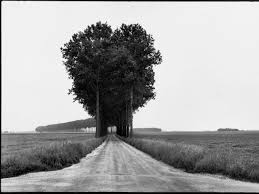
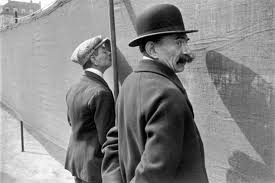
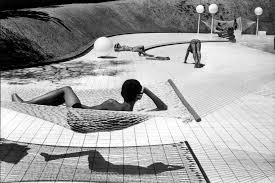
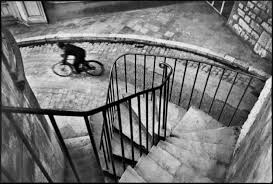
William Klein Philosophy
William Klein’s philosophy on photography was deeply rooted into breaking the photography rules and to embrace chaos that was around him. He didn’t care about traditional notions of composition, sharpness, and technical perfection, instead he favoured spontaneity, movement, and raw energy.
His approach was influenced by his background in painting, particularly his time studying under Fernand Léger, which had led him to view photography as a dynamic and expressive medium rather than a rigid art.
Klein believed that photography should ‘capture life as it is messy, unpredictable, and full of imperfections‘. He often used wide-angle lenses, close-up framing, and blur to create immersive, almost confrontational images.
His philosophy extended beyond photography into filmmaking, where he applied the same rebellious spirit to documentary and fashion films as time evolved.
One of his famous remarks, “If you look carefully at life, you see blur. Shake your hand. Blur is a part of life,” shows his belief that imperfections are not flaws but are essential elements of reality.
His work challenged the polished aesthetics of traditional photography, making way for a more expressive and emotionally charged visual language.
Image Analysis of William Klein

Visual
This photo is very in your face, but Klein philosophy was’ Get close and personal’. This is how he interacted with his subjects.
Black an white will capture essence and also nostalgia, if you remove colour it enhances depth in the image and draws more attention to more detail in the image. High level of contrast in this image and there is strong tonal range shows a wider separation between the lightest and darkest areas.
In this image there is a lack of composition there can be confusion and disorganisation. Composition is very important in images, composition will guide the viewer’s eye and it creates balance, and reinforcing the intended mood or message.
Technical
In all of Klein’s images he uses natural lighting.
He would have also used a wide angle lens so he could capture the whole image.
Klein later described it as a kind of “double self-portrait.
Klein also doesn’t care about the ISO setting on the camera and the haven’t took part in this image.
Klein’s uses blur, grain, and certain angles that can be challenged the idea that photographs had to be technically “perfect” to be powerful.
Contextual and Conceptual
William Klein’s ‘Kid with Gun‘ stunned the conventions of street photography by embracing chaos, confrontation, and subjectivity and qualities that were largely avoided in the genre at the time.
The idea of the camera as a weapon of expression echoes through decades of street and documentary photography.
William Klein Mood-board
